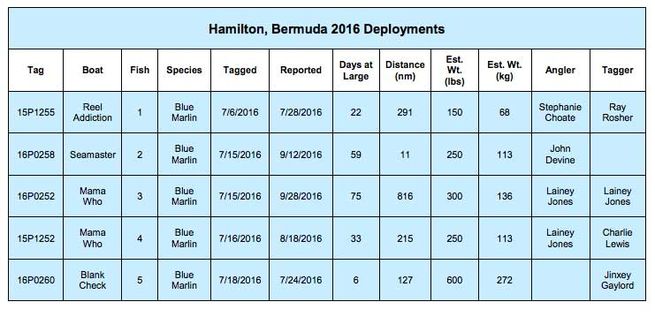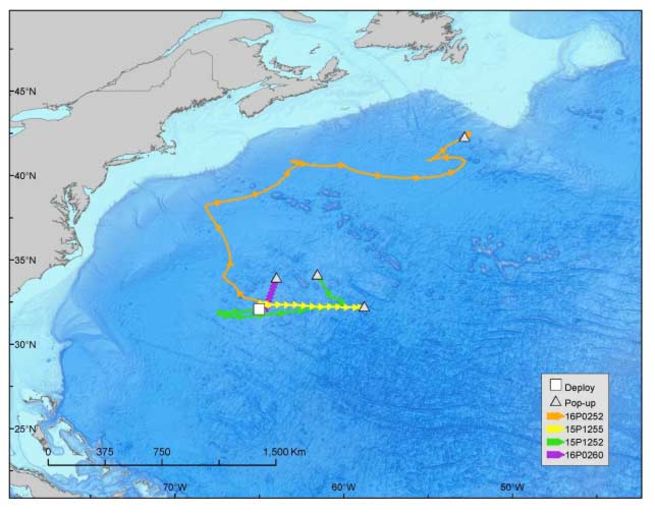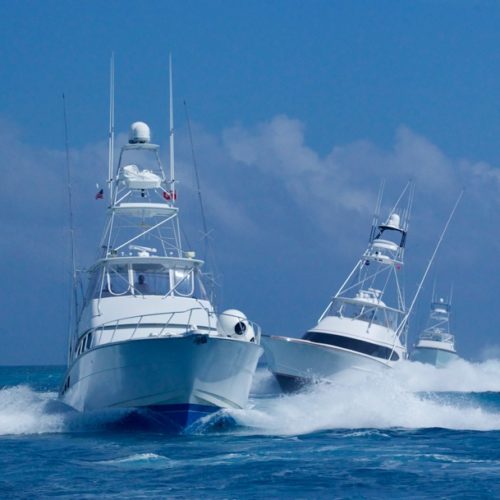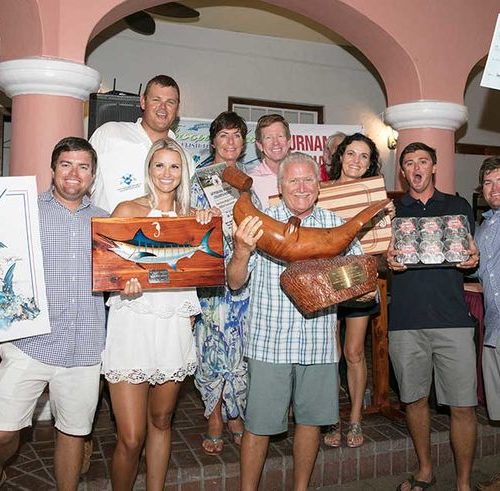
Bermuda marlin fishing kicked off the first week of July with the Bermuda Billfish Blast where eight satellite tags were generously sponsored for deployment on some healthy blue marlin. In the afternoon of the third day of the Blast, on July 6, 2016, while fishing aboard Reel Addiction with Captain Craigin Curtis, IGFA Representative and tag sponsor Stephanie Choate quickly reeled in an estimated 68 kg (150 lb) blue marlin that Captain Ray Rosher released with the first satellite tag of the 2016 Bermuda IGMR.
The second tag in the event was deployed during the Bermuda Big Game Classic, the second leg of the Bermuda Triple Crown Billfish Championship. On July 15, in the morning of the second day of fishing, John Devine fought an estimated113 kg (250 lb) blue marlin while fishing aboard Seamaster captained by Nick Vertue. The tag was generously sponsored by Team Persistence’s Dan Devine.
About an hour later, IGFA Lifetime Member and Tag Sponsor Lainey Jones released the third satellite tag of the race on an estimated 136 kg (300 lb) blue marlin after she quickly fought the fish from her boat Mama Who captained by Will Thorhill. Lainey graciously sponsored three tags in the inaugural 2015 Bermuda IGMR and continued the generosity with two tags sponsored in this 2016 Race.
The following day and last day of fishing in the Classic, on July 16, 2016, Lainey’s second satellite tag was deployed on an estimated 113 kg (250 lb) blue marlin by Charlie Lewis after Lainey fought the fish for about 10 minutes. She wrote on the data sheet that the fish was healthy when it swam away with the fourth tag of the event.
Just before the start of the Sea Horse Anglers Club Billfish Tournament, the final satellite tag of the Bermuda IGMR was deployed two days later on July 18, 2016 by Jinxey Gaylord on the largest marlin of the race, an estimated 272 kg (600 lb) blue marlin while fishing with Blank Check Captain Danny Hearn. This is the second tag that Tag Sponsor Dan Doyle Sr. has sponsored for the IGMR and we are thankful for his continued support.
The three other tags in the race that were not deployed, and will be carried over to the 2017 Bermuda IGMR, were sponsored by Last Stall’s Dan Murphy, Fa La Me’s Frank Rodriguez, and Foreign Exchange’s Spencer Butterfield. Both Dan Murphy and Frank Rodriguez also sponsored tags for the 2015 Bermuda IGMR in which Dan Murphy took first place and Frank Rodriguez took third.


The tag on Fish 5 Team Blank Check (Tag 16P0260) was the first tag of the event to surface on July 24, 2016 after 6 days at liberty, taking fourth place in the event. After deployment, the fish traveled east and then north around Bermuda before the tag popped off 127 nautical miles (nm) northeast of the deployment location, only slightly shorter than the total estimated distance of 135 nm*. During the deployment, the blue marlin primarily stayed above the 20°C thermocline and within 10 m (33 ft) of the surface approximately 40% of the time, with 55% of the dives occurring from 50-150 m (164 – 492 ft) where the temperatures ranged between 20 – 26°C (68 – 79°F). The maximum depth the fish reached during the deployment was 216 m (708 ft) where it experienced the coldest water temperature of 19.6°C (67°F).
On July 28, 2016, the second tag surfaced after popping off Fish 1 Team Reel Addiction (Tag15P1255). During the 22-day deployment, the fish traveled due east before the tag popped off 291 nm away, taking second place in the event. This straight-line course is evident with a total distance we estimate to be 309 nm*. The blue marlin remained above the 20°C thermocline for the duration of the track, with the exception being a deep dive to 208 m (682 ft) where the water temperature was 19.6°C. The fish was at or near the surface for approximately 50% of the time and the majority of its dives were between 50 – 100 m (164 – 328 ft) with only occasional deeper dives. Water temperatures experienced during those dives were between 20 – 26°C (68 – 79°F) whereas surface temperatures where generally between 28 – 30°C (82 – 86°F). On August 18, 2016, the tag on Fish 4 Team Mama Who Tag 2 (Tag 15P1252) surfaced 215 nm away from where it was deployed after 33 days at liberty, taking third place in the event.
Following deployment, the fish initially traveled west before turning back east in early August and then north before the tag popped off for a total estimated distance of 757 nm*. Interestingly, this blue marlin routinely dove below the 20°C thermocline with its deepest dive in early August to an incredible depth of 640 m (2,099 ft), where the water temperature was 15.2°C (59°F), the coldest temperature experienced during the deployment! This dive was significantly deeper than all of its other dives, which were typically above 300 m (984 ft). The fish spent slightly more than 50% of the time near the surface where water temperatures where ranged from 26 – 30 °C (79 – 86°F). When at depth, the fish was primarily between 25 – 100 m (82 – 328 ft) with smaller amounts of time between 100 – 250 m (328 – 820 ft) where the water temperatures ranged from 18 – 24°C (64 – 75°F).
The tag on Fish 2 Team Persistence (Tag 16P0258) was the next to surface on September 12, 2016, only 11 nm from the original tagging location after 59 days at liberty, taking fifth place in the event. The data suggests that the blue marlin died shortly after tagging and the tag was ingested by a deep-water animal. There is no light data until the tag surfaces, and the depth data oscillates between 600 – 800 m (1,968 – 2,624 ft) for the majority of the deployment but dives get deeper near the end of the deployment where the maximum depth of 1,488 m (4,882 ft) was reached. Since recorded temperature changes in response to depth, we know the animal was ectothermic. Although it is disappointing not to get data and a track on the marlin, this type of data is very interesting.
The tag on Fish 3 Mama Who Tag 1 (Tag 16P0252) was the final tag in the event to surface and it did so on September 28, 2016, 816 nm from the deployment location after 75 days at large, earning first place in the 2016 Bermuda IGMR! After deployment, the blue marlin swam north towards the Northeastern United States, and then turned northeast where it generally followed the continental shelf from offshore. The tag surfaced about 500 nm east of Nova Scotia and south of the Grand Banks after traveling an estimated total distance of 1,616 nm*. The diving behavior of this fish generally followed the 20°C thermocline with periodic dives into colder water. The blue marlin’s deepest dive occurred in early August to a depth of 280 m (918 ft). However, the coldest water it experienced was 15°C (59°F) in mid-August when the fish dove to a depth of 88 m (288 ft) while the fish was in the Northwest Atlantic. This fish spent approximately 75% of the time at the surface, and approximately 20% of the time between 25 – 150 m (82 – 492 ft). The fish spent approximately 90% of the time in water between 24 – 28°C (75 – 82°F) with occasional time spent in colder waters. Congratulations to Team Mama Who for taking first place in the event!
Although all five of the deployed tags reported and recorded a total combined distance of 1,460 nm, it was concerning to us that the deployments ranged between 6 and 75 days (each tag was programmed for 240 days). And although there is risk, as with any wildlife tagging program, of early release or the tags not reporting at all, this was quite unusual given the successes in the inaugural event the previous summer. Wildlife Computers, the tag manufacturers, concluded that there was an issue with the tag’s nosecone causing the pin to sever before the scheduled pop-up date, resulting in the premature release of the tag. Determined to rectify the problem, Wildlife Computers replaced all of the tags (which will be delivered to the sponsors in Bermuda this summer, for redeployment in the 2017 Triple Crown Billfish Championship.
Despite the short deployment durations for this event, we were still able to gather some interesting information. Interestingly, the blue marlin tagged in 2016 took a much more northerly route compared to fish in 2015. Noteworthy is the path taken by Fish 3, which followed the continental shelf towards Nova Scotia. Although one of the fish in the 2015 event made a short detour north towards the continental shelf before heading south towards the equator (the rest of the fish tagged in 2015 moved southeast towards the equator), Fish 3 in this event spent a much greater amount of time north. Fish 4 and 5 also started on a northerly course before their tags popped off. There’s no indication of 2016 fish swimming south, but the tags didn’t stay with them long enough to know definitively. We look forward to the 2017 event to see if there is continued use of habitat in the north or if the fish follow similar paths as 2015 in which they primarily traveled on a southeasterly route.
We are very excited to add more data from Atlantic blue marlin to the IGMR database and hope to increase this data set in years to come as tag issues are rectified. We are grateful to the tag sponsors, captains, anglers, crew, Dan Jacobs, Lynda Wilson, and all other participants that made the 2016 Hamilton, Bermuda IGMR so successful. These datasets help us to learn about billfish behavior in an effort to increase their conservation and protect the sport we love for future generations of fishing!
See full race report
*The total estimated distance is based on the length of a “best-guess” track calculated using light and sea surface temperature measurements from the tag and a complex mathematical algorithm. Since each location along the track potentially has significant error associated with it, the IGMR instead uses the reliable and more precise linear distance (the point of tag deployment determined by GPS to the point of tag pop-up determined by Argos satellites) to establish IGMR results and winners.

